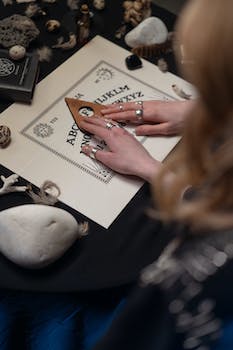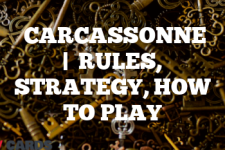Ouija: Unveiling the Mysteries of the Spirit Board
Introduction
I have always been fascinated by the Ouija board, especially how often it shows up in pop-culture in some spooky-adjacent show. They tend to interest people interested in the unknown, featuring storylines that revolve around ghosts, monsters, aliens, parallel universes, and other supernatural elements. The constant use of these themes in pop culture underscores society’s enduring interest in the eerie and inexplicable things that a lot of us feel about our universe.

The Ouija board, also known as a spirit board or talking board, is a flat board marked with the letters of the alphabet, the numbers 0-9, the words “yes”, “no”, “hello” (occasionally), and “goodbye”, along with various symbols and graphics. It uses a small heart-shaped piece of wood or plastic called a planchette. Participants place their fingers on the planchette, and it is moved about the board to spell out words. Ouija is a game that has intrigued and mystified players for over a century.
The history of the Ouija board is quite fascinating. It was first introduced by businessman Elijah Bond in 1890 as a parlor game. The name “Ouija” was said to be an ancient Egyptian word meaning “good luck”, though this has been disputed. Regardless of its origins, the Ouija board has become a popular tool for attempting to communicate with the spirit world, though many consider it just a game.
Quick Tip to Play Ouija
Always say goodbye. This is considered a polite way to end the session and close any spiritual doors you may have opened.
Talking boards, which have been around in some form since just after 1848, hold historical significance and are linked to the birth of Modern Spiritualism. Many Americans are familiar with the most well-known talking board, Ouija, which was first brought to the public in 1890 by the Kennard Novelty Company. Today, it’s being sold by Hasbro, Inc.
From its inception, the Ouija board has contended with intense competition from other manufacturers. They’ve produced hundreds of differing, albeit vibrant, talking board versions. These were purchased, relished, and ultimately tossed away, only to be recreated and unearthed by subsequent generations. Consequently, these boards epitomize a persistent pop culture trend and a significant forgotten art form.
Rules for playing Ouija
The official rules for playing Ouija are quite simple:
- Place the board on a flat surface.
- Two or more players place their fingers lightly on the planchette.
- One player asks a question.
- Wait for the planchette to move across the board and spell out the answer.
- When you’re finished playing, move the planchette to “Goodbye”.
There are also many ‘house rules’ that players have developed over the years, such as not playing alone, not asking about death, and always saying goodbye at the end of a session.
How to Play Ouija
Setup
Place the Ouija board on a flat surface and sit around it. Each player should place two fingers lightly on the planchette.
Gameplay
One player asks a question. It can be anything, but questions with simple yes or no answers work best. Then, wait for the planchette to move. It may take a few minutes, so be patient. The planchette will spell out the answer by pointing to the letters on the board.
End of the Game
The game ends when you decide to stop playing. To do this, move the planchette to “Goodbye” and remove your fingers.
How to Be Good at Ouija
Ouija isn’t about beating the other players, but about having a successful session. Here are some strategies to help you achieve this:
- Be patient. It can take time for the planchette to start moving.
- Ask clear, simple questions. This makes it easier for the planchette to provide a clear answer.
- Keep an open mind. If you’re skeptical, you may subconsciously influence the movement of the planchette.
- Always say goodbye. This is considered a polite way to end the session and close any spiritual doors you may have opened.
Best Strategies for playing Ouija game
The best strategies for playing Ouija involve creating the right atmosphere and approaching the game with the right mindset. Here are some tips:
- Create a calm, quiet environment. This can help you focus and make it easier to perceive subtle movements of the planchette.
- Play with people you trust. This can make the game more enjoyable and less scary.
- Don’t take it too seriously. Remember, it’s just a game.
- Be respectful. If you believe in the spirit world, being respectful can only help your chances of having a positive experience.
Scenarios for Ouija
There are many scenarios you might encounter when playing Ouija. Here are a few, along with some strategies for dealing with them:
- The planchette isn’t moving. This is common, especially for new players. Be patient and try asking another question.
- The planchette is moving quickly and erratically. This can be exciting, but it can also make it hard to read the message. Ask the spirit to slow down.
- You’re getting nonsensical answers. This can happen if the question was unclear or too complex. Try asking simpler questions.
- You’re feeling scared or uncomfortable. It’s okay to stop playing at any time. Just move the planchette to “Goodbye” and remove your fingers from it.
Frequently Asked Questions about playing Ouija game
- Is Ouija dangerous? There’s no scientific evidence that Ouija is dangerous. However, it can be scary for some people, especially if they believe in the spirit world.
- Can you play Ouija alone? It’s possible, but many people find it more fun to play with others.
- Do you have to say goodbye at the end of a session? It’s not required, but it’s considered good etiquette.
- What if the planchette doesn’t move? Be patient and try asking another question. It can take time for the planchette to start moving.
- Can children play Ouija? Ouija is recommended for ages 8 and up. However, it’s up to parents to decide if it’s appropriate for their child.
External Links
For more information, visit the official ‘Talking Board Society’ for Ouija website here.

A digital native around since the early days of online gaming communities around 2001. An early contributor to the cult gaming site ClanTemplates, Adam has spent years giving free gaming resources to the community. With BoardCards, Adam is most experienced and commonly writing the articles on Strategy multi-player games like Settlers of Catan and Avalon. His first introduction to board games was via Mancala, an Egyptian-origin stone game and one of the oldest known games still played worldwide. Contact me via email



